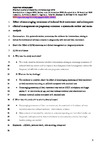Effect of encouraging awareness of reduced fetal movement and subsequent clinical management on pregnancy outcome: a systematic review and meta-analysis
| dc.contributor.author | HAYES, MDJL | |
| dc.contributor.author | DUMVILLE, JC | |
| dc.contributor.author | WALSH, T | |
| dc.contributor.author | HIGGINS, LE | |
| dc.contributor.author | Fisher, Margaret | |
| dc.contributor.author | AKSELSSON, A | |
| dc.contributor.author | WHITWORTH, M | |
| dc.contributor.author | HEAZELL, AEP | |
| dc.date.accessioned | 2022-12-12T11:10:08Z | |
| dc.date.available | 2022-12-12T11:10:08Z | |
| dc.date.issued | 2022-12-05 | |
| dc.identifier.issn | 2589-9333 | |
| dc.identifier.issn | 2589-9333 | |
| dc.identifier.other | 100821 | |
| dc.identifier.uri | http://hdl.handle.net/10026.1/20063 | |
| dc.description.abstract |
Objective Reduced fetal movement (RFM), defined as a decrease in maternal perception of frequency or strength of fetal movements, is a common reason for presentation to maternity care. Observational studies demonstrate an association between RFM, stillbirth, and fetal growth restriction related to placental insufficiency. However, individual intervention studies have described varying results. This systematic review and meta-analysis aimed to determine whether interventions aiming to encourage awareness of reduced fetal movement and/or improve its subsequent clinical management reduce the frequency of stillbirth or other important secondary outcomes. Data sources Searches were conducted in MEDLINE, EMBASE, CINAHL, The Cochrane Library, Web of Science and Google Scholar. Guidelines, trial registries, and grey literature were also searched. Databases were searched from inception to the 20th January 2022. Study eligibility criteria Randomised controlled trials (RCTs) and controlled non-randomised studies (NRS) were eligible if they assessed interventions aiming to encourage awareness of fetal movement or fetal movement counting and/or improve the subsequent clinical management of RFM. Eligible populations were singleton pregnancies after 24 completed weeks of gestation. The primary review outcome was stillbirth; a number of secondary maternal and neonatal outcomes were specified in the review. Study appraisal and synthesis methods Risk of bias was assessed using Cochrane Risk of Bias 2 and ROBINS-I for RCTs and NRS respectively. Variation due to heterogeneity was assessed using I2. Data from studies employing similar interventions was combined using random effects meta-analysis. Results 1,609 citations were identified; 190 full text papers were evaluated against the inclusion criteria, 18 studies (16 RCTs and 2 NRS) were included. The evidence is uncertain about the effect of encouraging awareness of fetal movement on stillbirth compared with standard care (two studies, n=330,084); pooled aOR 1.19 (95% CI 0.96, 1.47). Interventions for encouraging awareness of fetal movement may be associated with a reduction in NICU admissions and Apgar scores <7 at five minutes of age and may not be associated with increases in caesarean section or induction of labour. The evidence is uncertain about the effect of encouraging fetal movement counting on stillbirth compared with standard care; pooled OR 0.69 (95% CI 0.18, 2.65), data from three RCTs (n=70,584). Counting fetal movements may increase maternal fetal attachment and decrease anxiety compared with standard care. When comparing combined interventions of fetal movement awareness and subsequent clinical management with standard care (one study, n=393,857) the evidence is uncertain about the effect on stillbirth (aOR 0.86, 95% CI 0.70, 1.05). Conclusions The effect of interventions for encouraging awareness of RFM alone or in combination with subsequent clinical management on stillbirth is uncertain. Encouraging awareness of fetal movement may be associated with reduced adverse neonatal outcomes without an increase in interventions in labour. Meta-analysis is hampered by variation in interventions, outcome reporting and definitions. Individual studies are frequently underpowered to detect a reduction in severe, rare outcomes and no studies were included from high-burden settings. Studies from such settings are needed to determine whether interventions can reduce stillbirth. | |
| dc.format.extent | 100821-100821 | |
| dc.format.medium | Print-Electronic | |
| dc.language | en | |
| dc.language.iso | en | |
| dc.publisher | Elsevier BV | |
| dc.rights | Attribution-NonCommercial-ShareAlike 4.0 International | |
| dc.rights.uri | http://creativecommons.org/licenses/by-nc-sa/4.0/ | |
| dc.subject | kick counting | |
| dc.subject | perinatal death | |
| dc.subject | stillbirth | |
| dc.subject | ultrasound | |
| dc.subject | Infant, Newborn | |
| dc.subject | Pregnancy | |
| dc.subject | Female | |
| dc.subject | Humans | |
| dc.subject | Stillbirth | |
| dc.subject | Fetal Movement | |
| dc.subject | Placenta | |
| dc.subject | Maternal Health Services | |
| dc.subject | Labor, Obstetric | |
| dc.title | Effect of encouraging awareness of reduced fetal movement and subsequent clinical management on pregnancy outcome: a systematic review and meta-analysis | |
| dc.type | journal-article | |
| dc.type | Meta-Analysis | |
| dc.type | Systematic Review | |
| dc.type | Journal Article | |
| dc.type | Review | |
| dc.type | Research Support, Non-U.S. Gov't | |
| plymouth.author-url | https://www.ncbi.nlm.nih.gov/pubmed/36481411 | |
| plymouth.issue | 3 | |
| plymouth.volume | 5 | |
| plymouth.publication-status | Published | |
| plymouth.journal | American Journal of Obstetrics & Gynecology MFM | |
| dc.identifier.doi | 10.1016/j.ajogmf.2022.100821 | |
| plymouth.organisational-group | /Plymouth | |
| plymouth.organisational-group | /Plymouth/Faculty of Health | |
| plymouth.organisational-group | /Plymouth/Faculty of Health/School of Nursing and Midwifery | |
| plymouth.organisational-group | /Plymouth/Users by role | |
| plymouth.organisational-group | /Plymouth/Users by role/Academics | |
| dc.publisher.place | United States | |
| dcterms.dateAccepted | 2022-11-28 | |
| dc.rights.embargodate | 2022-12-13 | |
| dc.identifier.eissn | 2589-9333 | |
| rioxxterms.versionofrecord | 10.1016/j.ajogmf.2022.100821 | |
| rioxxterms.licenseref.uri | http://creativecommons.org/licenses/by-nc-sa/4.0/ | |
| rioxxterms.type | Journal Article/Review |



